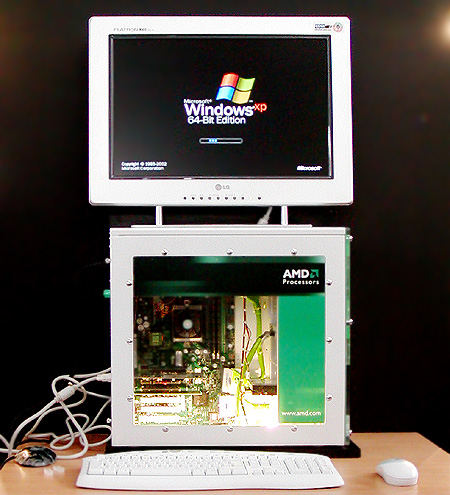If you ever bothered to take a look at one of the 64-bit Longhorn compiles, you may have noticed that most of these builds are extremely empty and lack, as one example, the sidebar. There’s a good reason why these compiles lack lots of features the x86 Longhorn compiles did have.
A new architecture
When the development of Longhorn began, the 64-bit processors we know today were not yet available. In 1994 Hewlett Packard partnered with Intel to create a new 64-bit architecture based on an earlier development called “EPIC”. This joint venture resulted in the IA-64 architecture that was used with Intel’s Itanium range of processors. This IA-64 architecture maintained no backwards compatibility with x86 instructions, requiring slow software emulation in order to support existing software. The first Itanium processor was launched in June 2001.
In reaction to Intel’s IA-64 architecture, AMD began development of its own architecture. AMD’s new architecture was an extension of x86 and still supported all legacy instructions. For this reason it was often called x86-64. AMD released its first 64-bit processor (the Opteron) in April 2003. AMD’s architecture is often referenced as AMD64. Nowadays, x64 editions of Windows still carry a AMD64 tag in their build string. After AMD64 was a fact, Intel also started working on an x86-64 processor. Intel implemented the same instruction set AMD had created, but made some minor changes. This resulted in the EM64T architecture (later renamed to Intel64). Generally, all x86-64 processors are just labelled x64 or AMD64.
A new Windows
With the new x64 architecture and its extended capabilities, a new version of Windows was also needed to take full advantage of those capabilities. While installing an x86 edition of Windows on x64 hardware is more than possible, it’s not going to get you any additional performance. To get the most out of 64-bit, a x64 edition of Windows was developed based on the Server 2003 codebase. The first known compile of AMD64 Windows was 5.2.3754, compiled on 23rd January 2003. At this stage, AMD64 support was still being developed within its own special lab (dnsrv_amd64), rather than support being availale and ready in the trunk. This build still uses the ‘64-bit Edition’ branding that was meant for IA-64 Windows editions. Much later, around Q2 2004, builds started using the final “x64 Edition” branding. The first x64 Windows builds were rather primitive in that they were unable to run some standard x86 Windows applications.
Windows on Windows
To solve software compatibility a compatibility layer was added to both IA-64 and x64 editions of Windows. This layer is called “Windows on Windows” or WoW. In x64 editions of Windows, WoW provides legacy x86 applications with x86 versions of common used/referenced Windows files in C:\Windows\sysWoW64 and also an x86 copy of the registry in WoW6432Node. When an x86 application is run the processor switches to legacy (x86) mode, so no emulation is needed. In IA-64 editions, WoW handles all tasks described above, but in addition also emulates the x86 architecture since IA-64 is completely incompatible with x86 instructions.
WoW core files:
- WoW64.dll
- WoW64win.dll
- WoW64cpu.dll

Windows XP demo on early AMD64 hardware
Compiling Windows for x64
The x64 edition of Windows is basically the same code as the x86 edition. The code is almost architecture neutral, it just has to be compiled by another compiler. This compiler depends on the target architecture’s instruction set. Some parts of Windows that are not written in higher-level languages (C or C++) do require a rewrite. An example is the Hardware Abstraction Layer (HAL), which is partially written in the architecture specific language assembly.
Longhorn x64
So, why are Longhorn x64 builds so empty? Firstly, you have to take into account that at the time the first x64 Longhorn build appeared (October 1st 2003) the x64 was still very new and work was still being done. More importantly, a x64 edition of the .NET framework was not available at the time. This is the exact reason the earlier x64 Longhorn versions lack all the fancy user interface related stuff: sidebar, preview panel, search pages, help and support… It’s all not there since all those features rely on .NET. Of course, the x86 .NET edition could have been used, but what’s the point in having a x64 enabled computer when all software is running in x86-mode anyway? Build 4083 is a bit special in that it has the base .NET framework implemented. Even so, the Avalon API was not yet fully implemented on x64.